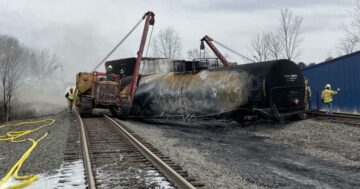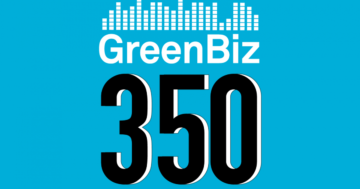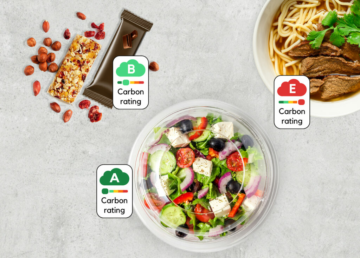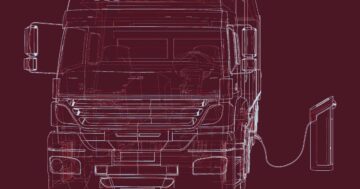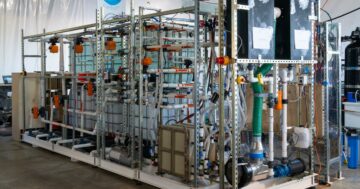
Switzerland-based Climeworks recently announced its next phase of capturing carbon dioxide with its Generation 3 direct air capture (DAC) technology.
The Generation 3 tech is able to capture twice the CO2 per module compared with its predecessor while cutting its energy consumption and associated costs in half, according to the startup.
It achieves this feat with an upgraded filter that increases direct surface contact with the CO2, which leads to increased capture totals and decreased time spent.
Advancement in DAC technology such as Generation 3 “has become a primary focus for corporate and other large investors in [carbon dioxide removal],” according to CarbonBrief’s recently released “The State of Carbon Dioxide Removal 2024” report.
“Major CDR startups such as Climeworks and Carbon Engineering have received investments from corporations that are looking to offset emissions from their core businesses (Microsoft, Airbus, Chevron, JP Morgan),” according to the report.
Climeworks’ Orca and Mammoth
Climeworks’ first commercial-scale carbon dioxide removal plant was Orca, based in Iceland. Orca was a culmination of previous, smaller-scale DAC plants with the additional ability to permanently store captured carbon into the earth.
Orca’s technology is classified by Climeworks as second generation, and consists of large fans — or collector containers — moving air through a filter that catches the CO2. The CO2 is then mixed with water and injected for permanent storage into the earth. Orca is capable of capturing around 4,000 tons of carbon annually from the atmosphere.
Climeworks broke ground on its Mammoth plant in June 2022. Mammoth uses the same technology as Orca, but on a larger scale. Where Orca has eight collector containers capturing carbon, Mammoth has 72, leading to an annual capture cap of 36,000 tons of carbon.
Maintaining momentum with DAC
Commercial-scale DAC is becoming a reality, and that’s due in part to the passage of complementary policy. According to the CarbonBrief report, “national-level carbon dioxide removal (CDR) policy has made some progress in supporting scientific research and demonstration for novel CDR.”
In the U.S., legislation such as the Bipartisan Infrastructure Law and the Inflation Reduction Act created or expanded upon existing tax incentives for companies to use carbon capture technology. The Biden administration has even gone so far as to require new and existing plants within hard-to-abate sectors to install carbon capture technology before 2039.
But to maintain momentum, the report strongly suggests the clarification and creation of further policy to provide structure. This includes creating universally acknowledged and adhered to certifications for the burgeoning — and often corrupt — volunteer carbon market, in addition to more federal subsidies.
In 2023, Climeworks received $1.2 billion from the DOE’s Regional Direct Air Capture Hubs program to open two DAC facilities in Texas and Louisiana. Construction of the first plant to use the Generation 3 technology is planned to begin in Louisiana in 2026.
- SEO Powered Content & PR Distribution. Get Amplified Today.
- PlatoData.Network Vertical Generative Ai. Empower Yourself. Access Here.
- PlatoAiStream. Web3 Intelligence. Knowledge Amplified. Access Here.
- PlatoESG. Carbon, CleanTech, Energy, Environment, Solar, Waste Management. Access Here.
- PlatoHealth. Biotech and Clinical Trials Intelligence. Access Here.
- Source: https://www.greenbiz.com/article/climeworks-unveils-upgraded-carbon-capture-tech
- :has
- :is
- :where
- 000
- 10
- 2%
- 2022
- 2023
- 2024
- 2026
- 24
- 36
- 4
- 7
- 72
- a
- ability
- Able
- According
- Achieves
- acknowledged
- Act
- addition
- Additional
- adhered
- administration
- AIR
- Airbus
- alongside
- an
- and
- annual
- Annually
- ARE
- around
- AS
- associated
- At
- Atmosphere
- based
- become
- becoming
- before
- begin
- biden
- Biden Administration
- Billion
- bipartisan
- Broke
- burgeoning
- businesses
- but
- by
- cap
- capable
- capture
- captured
- Capturing
- carbon
- carbon capture
- carbon dioxide
- certifications
- chevron
- classified
- co2
- collector
- Companies
- compared
- complementary
- consists
- construction
- consumption
- contact
- Containers
- Core
- Corporate
- Corporations
- Costs
- created
- Creating
- creation
- cutting
- decreased
- demonstration
- direct
- due
- earth
- eight
- Emissions
- energy
- Energy Consumption
- Engineering
- Ether (ETH)
- Even
- existing
- expanded
- experts
- facilities
- fans
- far
- feat
- Federal
- filter
- First
- Focus
- For
- from
- further
- future
- generation
- gone
- Ground
- Half
- Have
- HTTPS
- hubs
- Iceland
- Impact
- in
- Incentives
- includes
- increased
- Increases
- inflation
- Infrastructure
- innovators
- into
- Investments
- Investors
- ITS
- jp
- jp morgan
- jpg
- june
- large
- larger
- Law
- leading
- Leads
- Legislation
- looking
- Louisiana
- made
- maintain
- major
- Market
- Microsoft
- mixed
- module
- Momentum
- more
- Morgan
- moving
- New
- next
- node
- novel
- Oct
- of
- offset
- often
- on
- open
- or
- Orca
- Other
- part
- passage
- per
- permanent
- permanently
- phase
- planned
- plant
- plants
- plato
- Plato Data Intelligence
- PlatoData
- policy
- predecessor
- previous
- primary
- Program
- Progress
- provide
- Reality
- received
- recently
- reduction
- regenerative
- regional
- released
- removal
- report
- require
- research
- s
- same
- San
- San Jose
- Scale
- scientific
- Scientific Research
- Second
- Second Generation
- Sectors
- So
- so Far
- some
- spent
- startup
- Startups
- State
- storage
- store
- strongly
- structure
- such
- Suggests
- Supercharge
- Supporting
- Surface
- tax
- tech
- Technology
- texas
- that
- The
- The State
- their
- then
- this
- Through
- time
- to
- tons
- Twice
- two
- u.s.
- universally
- Unveils
- upgraded
- upon
- use
- uses
- visionaries
- volunteer
- was
- Water
- Way..
- which
- while
- with
- within
- Your
- zephyrnet

